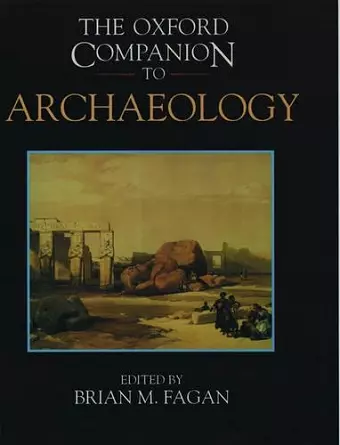The Oxford Companion to Archaeology
Format:Hardback
Publisher:Oxford University Press Inc
Published:13th Mar '97
Currently unavailable, and unfortunately no date known when it will be back

Named as an Outstanding Academic Book of 1997 by CHOICE
This overview of archaeology is intended for students of archaeology and anthropology.When we think of archaeology, most of us think first of its many spectacular finds: the legendary city of Troy, Tutankhamun's golden tomb, the three-million-year-old footprints at Laetoli, the mile-high city at Machu Picchu, the cave paintings at Lascaux. But as marvelous as these discoveries are, the ultimate goal of archaeology, and of archaeologists, is something far more ambitious. Indeed, it is one of humanity's great quests: to recapture and understand our human past, across vast stretches of time, as it was lived in every corner of the globe. Now, in The Oxford Companion to Archaeology, readers have a comprehensive and authoritative overview of this fascinating discipline, in a book that is itself a rare find, a treasure of up-to-date information on virtually every aspect of the field. The range of subjects covered here is breathtaking - everything from the domestication of the camel, to Egyptian hieroglyphics, to luminescence dating, to the Mayan calendar, to Koobi Fora and Olduvai Gorge. Readers will find extensive essays that illuminate the full history of archaeology - from the discovery of Herculaneum in 1783, to the recent finding of the `Ice Man' and the ancient city of Uruk - and engaging biographies of the great figures in the field, from Gertrude Bell, Paul Emile Botta, and Louis and Mary Leakey, to V. Gordon Childe, Li Chi, Heinrich Schliemann, and Max Uhle. The Companion offers extensive coverage of the methods used in archaeological research, revealing how archaeologists find sites (remote sensing, aerial photography, ground survey), how they map excavations and report findings, and how they analyse artifacts (radiocarbon dating, dendrochronology, stratigraphy, mortuary analysis). Of course, archaeology's great subject is humanity and human culture, and there are broad essays that examine human evolution - ranging from our early primate ancestors, to Australopithecus and Cro-Magnon, to Homo Erectus and Neanderthals - and explore the many general facets of culture, from art and architecture, to arms and armour, to beer and brewing, to astronomy and religion. And perhaps most important, the contributors provide insightful coverage of human culture as it has been expressed in every region of the world. Here entries range from broad overviews, to treatments of particular themes, to discussions...
The match between authors and topics is impressive. Fagan has somehow persuaded top archaeologists to write about what they know best. The Oxford Companion is aimed at students and serious professionals as well as the general public, and has strong entries dealing with ideas, political issues and intellectual principles. * Warwick Bray, Nature *
The 700 articles in its 840 pages are arranged alpgabetically, cross-referenced, and supplemented with maps and chronological tables. * Church Times *
A first place to start for all your future enquiries. * Anthony Sinclair, Antiquity, Volume 71, Number 272, June 1997 *
What is the difference between a companion, a dictionary, an encyclopedia ... In the case of The Oxford Companion to Archaeology, the answer is its sheer readability ... this volume may be pleasurably read from cover to cover ... It maintains a quality of writing and depth of analysis across a huge variety of topics ... this book is an authoritative and clearly written global assessment of archaeology that judiciously balances the well publicised with the less well known. * Times Higher Education Supplement *
Like all Oxford Companions, it aspires to be the definitive overview of the subject. * Church Times *
An excellent overview of what it is that archaeologists do and have done ... It ranges widely from the expected (Giza, Easter Island and so forth) to the unexpected (archaeology in science fiction), via some helpful, intelligent entries. * New Scientist *
- Winner of Named as an Outstanding Academic Book of 1997 by CHOICE.
ISBN: 9780195076189
Dimensions: 200mm x 246mm x 53mm
Weight: 1746g
864 pages